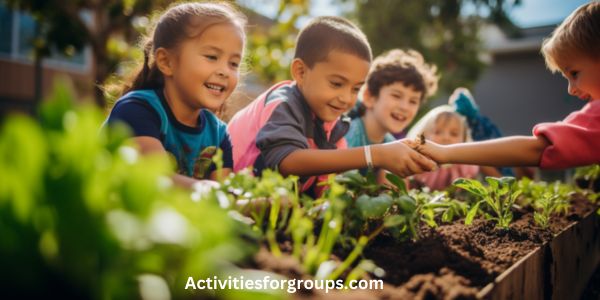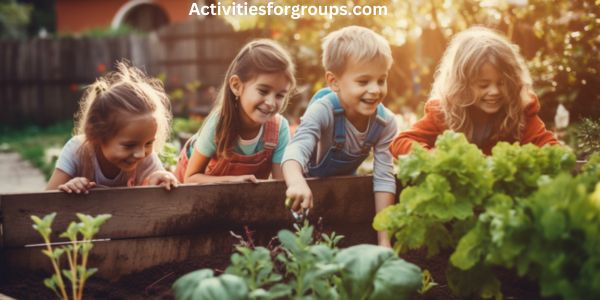Gardening is a great way to help kids appreciate nature and learn about the environment.
Group gardening projects provide a fun and educational opportunity for kids to work together and reap the rewards of a shared success.

successful group gardening projectsand tips on planning, selecting plants, and safety considerations for successful group gardening projects.
Benefits of Group Gardening Projects for Kids
You can reap many benefits from getting your kids involved in group gardening projects.
It’s an activity that teaches them responsibility, cooperation, and the principles of sustainable living. Plus, it’s a great way to get them outside and away from screens.
Group gardening projects offer a sense of community that’s hard to find in other activities. Working together with other kids to achieve a common goal builds communication and team-building skills. And there’s nothing more satisfying than watching a garden you’ve created grow and blossom over time.
Plus, gardening projects are a great way to learn about the environment and the importance of taking care of the planet. Kids can learn about the different types of plants, the different ways of caring for them, and the ecological systems that make them thrive.
Gardening is also a great way to learn about nutrition and food sources, as it encourages kids to explore different types of produce and how to prepare them.
Gardening projects can be tailored to any age group and any size group, so it can be a fun activity for the whole family.
Planning Your Group Gardening Project
Planning your group gardening project doesn’t have to be overwhelming.
Start by identifying your goals.
Select the right plants.
Assign roles to each member of the group.
With a clear plan in place, you’ll be well on your way to a successful project.
Identify Goals
Your group’s goal-setting is an important step in planning your gardening project. Brainstorm with the kids to figure out what they would like to achieve. Consider the type of project, the timeline, and the budget. Write down each goal and put them into a table for better understanding. The table should include the goal, how it will be achieved, and the estimated time it will take to complete.
| Goal | How to Achieve | Estimated Time |
|---|---|---|
| Plant a vegetable garden | Buy seeds and soil | 2 weeks |
| Build a compost bin | Gather materials and build | 3 days |
| Create a flower garden | Plant flowers and shrubs | 1 month |
Once the goals are identified, break them down into smaller tasks and assign each one to a group member. This will help the kids stay organized and motivated to finish the project. Furthermore, set checkpoints throughout the project to ensure the team is on track. With clear goals and tasks, you can ensure everyone is engaged and excited to complete the project.
Select Plants
Once you’ve identified your goals, it’s time to select plants for your group gardening project. Take into consideration the amount of space available, the climate of your location, and the amount of sunlight that your plants will receive.
Consider the age of the participants, and select plants that are easy to care for and will thrive in your environment. If you’re feeling adventurous, choose plants that have special properties like herbs with healing qualities, or edible fruits and vegetables. Make sure to pick plants that are safe to handle and won’t irritate sensitive skin.
Assign Roles
Now that you’ve chosen the plants for your group gardening project, it’s time to assign roles. A successful project requires careful planning and delegation of tasks. Here are some tips to help you make sure everyone in the group has a job to do:
-Divide tasks based on age:
- Younger kids: Watering, weeding, and labeling plants
- Older kids: Making plans, planting, and keeping records
-Make sure everyone has a job they enjoy:
- Creative kids: Designing a garden layout or making signs
- Outdoorsy kids: Preparing soil or collecting compost
-Encourage teamwork:
- Brainstorm ideas together
- Set group goals and deadlines
- *Take turns leading and helping out
Plant Selection for Group Gardening Projects

Choosing the right plants for a group gardening project is key to success. When selecting plants, you should consider what types of plants are best suited for the growing conditions of the site, as well as the needs of the group.
It’s also important to pick plants that are easy to care for and will grow happily together. Make sure to factor in the age of the kids in the group and pick plants that are appropriate for their level of care. For example, younger kids may not be able to handle high-maintenance plants correctly, while older kids can handle more delicate plants with care.
When it comes to group gardening projects, it’s important to pick plants that will benefit the group. Planting flowers or herbs can be a great way to brighten up a space and teach kids the joys of gardening.
Vegetables are also popular, as they can provide ample reward for the kids when the harvest comes in. Another consideration is to pick plants that will attract wildlife such as butterflies, bees, or birds. This can be a great way to teach kids about the environment and the importance of biodiversity.
When picking plants for a group gardening project, it’s important to get input from the kids involved in the project. This will help ensure that everyone is on board with the planting selection and will motivate them to take part in the gardening process. In addition, if the kids are familiar with the plants they’re planting, they’ll be more likely to take care of them.
Gardening Tools for Kids
Having the right gardening tools is essential for kids participating in a group gardening project. Depending on the age of the children involved, it’s important to provide them with tools that are easy to use, safe, and age-appropriate. Here are a few essential tools to consider for group gardening projects:
- Hand Tools:
- Gloves – leather or canvas gloves to protect hands
- Hand trowel – for digging and scooping
- Hand spade – for digging and loosening soil
- Hand rake – for loosening soil and removing weeds
- Power Tools:
- Electric tiller – for tilling and aerating soil
- Electric edger – for trimming and defining garden beds
- Cordless trimmer – for trimming grass and weeds
- Miscellaneous Tools:
- Hose – for watering
- Garden cart – for transporting tools and supplies
- Watering can – for watering plants in delicate areas
When selecting tools, look for sturdy, well-made pieces that are comfortable for the kids to handle. It’s a good idea to provide kid-sized tools, if available. Also, always supervise kids when using any power tool.
Safety Considerations for Group Gardening Projects
When choosing a group gardening project for kids, safety should always be a top priority. Make sure to do your research and choose a project that’s age-appropriate for all participants. If possible, choose a project that can be done outdoors or in a well-ventilated area. Be sure to provide safety gear, such as gloves and safety glasses, to all of the participants.
It is also important to inform the participants of the proper way to handle tools and gardening supplies. Make sure the kids know the correct way to use tools such as shovels, rakes, and hoes. Additionally, remind them not to run with sharp tools and to keep an eye out for any poisonous plants that may be in the area.
Finally, make sure that all participants are supervised at all times. Be sure to assign a responsible adult to oversee the project and to provide help if needed. If the project involves using any large machinery or tools, it’s important to make sure that there’s an adult present to operate the machinery and to provide assistance when needed.
Group gardening projects are a great way to introduce kids to the world of gardening and to instill in them a love of nature. With the right safety precautions in place, kids can enjoy these activities in a safe and responsible manner.
Troubleshooting Tips for Group Gardening Projects

If you’re having trouble with your group gardening project, you’re not alone. Working on a project as a group can add a lot of complexity, and sometimes things don’t go according to plan. But that doesn’t mean you have to give up.
Here are some troubleshooting tips to help you get your project back on track:
- Assess the Situation:
- Gather your group to discuss what went wrong.
- Talk through the problem to determine what could be causing it.
- Identify potential solutions.
- Adapt and Adjust:
- Try to come up with a plan that will help your group work around the problem.
- Determine what needs to change in order to move forward.
- Make sure everyone is on board with the plan.
- Keep Going:
- Don’t be afraid to make mistakes.
- Use them as an opportunity to learn and grow.
- Keep working towards your goal, even if it takes more time than expected.
These troubleshooting tips can help you stay on track with your group gardening project. With a little bit of patience and flexibility, you’ll be able to work through any issue.
Frequently Asked Questions [FAQs]
What Is the Best Time of Year to Start a Group Gardening Project?
You should start a group gardening project in the spring. It’s the perfect time for growing, plus the warmer weather will make outdoor work much more enjoyable.
Is There a Minimum Age Requirement for Kids to Participate in Group Gardening Projects?
Do you need a minimum age for kids to participate in group gardening projects? It depends on the project – usually it’s recommended for kids aged 6 and up. Younger children may join with parental guidance.
How Much Space Is Needed for a Group Gardening Project?
How much space do you need? It depends on the size of the group and the type of project. Generally, a few feet of open ground is sufficient.
Is It Necessary for All Participants to Have Gardening Experience?
No, it’s not necessary for all participants to have gardening experience. Even novices can learn new skills and have fun with a group project.
Can Group Gardening Projects Be Undertaken Indoors?
Yes, group gardening projects can be undertaken indoors. You can create a container garden or hydroponic system to bring the outdoors in. With the right supplies and a bit of creativity, you can have a thriving garden indoors.
Conclusion
Group gardening projects can be a great way to bring kids together and teach them valuable skills. With the right planning, selection of plants, tools, and safety considerations, your group gardening project is sure to be a success.
Have fun and enjoy the fruits of your labor!




Leave a Reply